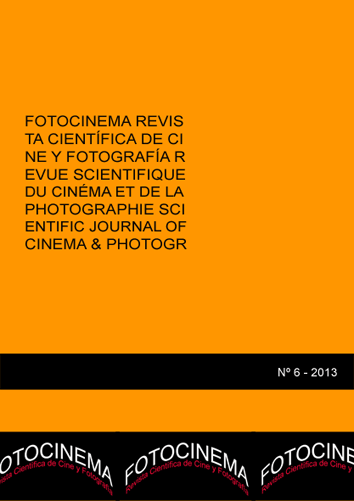El cine norteamericano durante la Gran Depresión (1929-1939)
DOI:
https://doi.org/10.24310/Fotocinema.2013.v0i6.5914Abstract
El cine comienza su andadura a finales del siglo XIX como un mero entretenimiento de masas, revelando a un público ávido de novedades las posibilidades del reciente descubrimiento. Será a partir de la Revolución bolchevique de 1917 cuando los organismos de poder descubran la capacidad de la imagen en movimiento como herramienta de propaganda ideológica. Los regímenes comunista y fascista se sirvieron del cine para difundir su doctrina y en la democracia de Estados Unidos, durante el período del New Deal (1933-1939), el cine clásico de Hollywood desempeñará la misma función propagandística, aunque haciendo uso de lenguajes y géneros variados y, con frecuencia, mucho más sofisticados. Es precisamente esta faceta del Séptimo Arte, su uso como agente difusor de ideologías, la que nos interesa y se analiza en el presente artículo.
Palabras clave: Política cultural del New Deal; cine como ideología; Ernest Lubitsch; King Vidor; Frank Capra
The cinema begins its career in the late nineteenth century as a mere mass entertainment, revealing to an eager audience the possibilities of the new discovery. It was from the Bolshevik Revolution of 1917 when the power of the moving image as ideological propaganda tool was discovered by the governments. The communist and fascist regimes used the cinema to spread their doctrines and in the American democracy, during the New Deal period (1933-1939), the classical Hollywood cinema will perform the same propaganda function, but using different languages ??and genres, and often much more sophisticated. It is this aspect of the cinema, its use as a carier of ideologies, that interests us and analyze this article.
Keywords: Cultural policy of the New Deal; cinema as ideology; Ernest Lubitsch; King Vidor; Frank Capra
Downloads
Metrics
Publication Facts
Reviewer profiles N/A
Author statements
Indexed in
-
—
- Academic society
- N/A
- Publisher
- Universidad de Málaga
Downloads
Published
How to Cite
Issue
Section
License
All contents published in Fotocinema Revista científica de cine y fotografía are protected under the Creative Commons Attribution-NonCommercial-ShareAlike 4.0 International (CC BY-NC-SA 4.0) license. All about this license is available in the following link: <http://creativecommons.org/licenses/by-nc-sa/4.0>
Users can copy, use, redistribute, share and exhibit publicly as long as:
- The original source and authorship of the material are cited (Journal, Publisher and URL of the work).
- It is not used for comercial purposes.
- The existence of the license and its especifications are mentioned.
There are two sets of authors’ rights: moral and property rights. Moral rights are perpetual prerogatives, unrenounceable, not-transferable, unalienable, imprescriptible and inembargable. According to authors’ rights legislation, Fotocinema. Revista científica de cine y fotografía recognizes and respects authors moral rights, as well as the ownership of property rights, which will be transferred to University of Malaga in open access. The property rights are referred to the benefits that are gained by the use or the dissemination of works. Fotocinema. Revista científica de cine y fotografía is published in an open access form and it is exclusively licenced by any means for doing or authorising distribution, dissemination, reproduction, , adaptation, translation or arrangement of works.
Authors are responsable for obtaining the necessary permission to use copyrighted images.














13.png)



